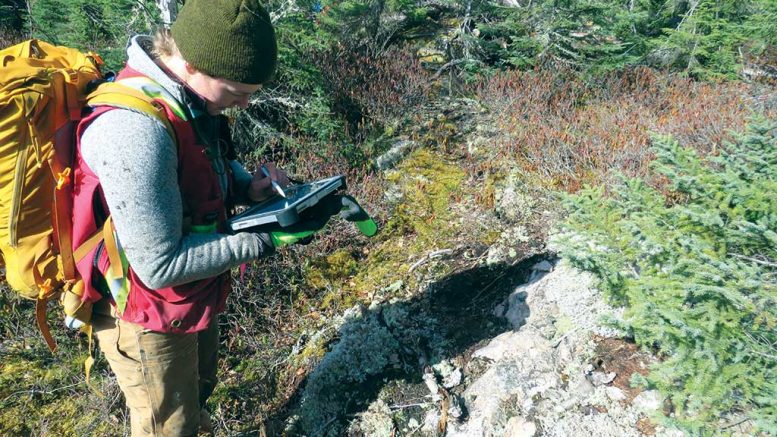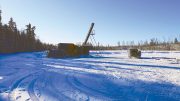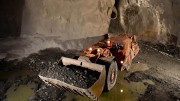In April 2019, Great Bear Resources (TSXV: GBR; US-OTC: GTBDF) doubled the 30,000-metre drill program at its Dixie gold project in Ontario’s Red Lake district.
At the time the company had drilled 12,000 of the first 30,000 metres. It expects to finish the original program by July 2019, and spend the rest of the year drilling the other 30,000 metres.
Great Bear has two drill rigs on-site, but will add a third rig during the extended program. The two current rigs will continue expanding the project’s Hinge and Dixie Limb zones along strike and at depth, while the third rig will drill regional targets, as well as the Hinge and Dixie Limb.
Mineralization at the project starts almost at surface, covered by a few metres of gravel, and has been chased by the company down to 360 metres. It centers on a fold in the stratigraphy. On one side of the fold, at a geological contact, is the Dixie Limb zone. The Hinge zone, however, isn’t at the geological contact. It’s a vein swarm that runs parallel to the regional D2 fold axis.
“I don’t know how many of these things we’re ultimately going to have,” Great Bear president and CEO Chris Taylor says in an interview with The Northern Miner. “Maybe it’s just those two. But if you look at our geophysics, you can see there are potentially several of these fold axes that crossed the project. They all have to be drill tested to see what the scope of the gold system is in the big-picture sense.”
The expanded drill program will cost Great Bear $5.6 million. The company has $12 million in the treasury and $7.8 million of in-the-money warrants that will expire in 2019 and 2020. Taylor says the company expanded the program because results look promising.
In January 2019, the company reported a 10-metre wide vein zone grading 953.64 grams gold per tonne over 1 metre from 184 metres downhole at its lower contact, including 1,602.73 grams gold over 1 metre from 184 metres downhole in the project’s Hinge zone. The company drilled the hole to test its 3-D model, which accurately predicted veining would occur within 15 metres of the intercept.

Aerial view of Dixie Lake in northwestern Ontario’s Red Lake gold district. Credit: Great Bear Resources.
Other highlights from the Hinge zone include 68.76 grams gold over 7 metres from 125 metres downhole and 30.15 grams gold over 7 metres from 137 metres downhole. Highlights from Dixie Limb include 4.31 grams gold over 22 metres from 173 metres downhole and 16.84 grams gold over 10 metres from 162 metres downhole. The company has defined over 1 km of strike length across both Hinge and Dixie Limb.
Great Bear found Hinge in August 2018, sending its stock skyrocketing from 50¢ per share to nearly $2 per share.
Subsequently, Rob McEwen and McEwen Mining (TSX: MUX; NYSE: MUX) invested $6 million in Great Bear for 18.8% of the company on a partly diluted basis. McEwen himself invested $4.8 million.
“It was very exciting,” Taylor says. “We had Rob McEwen and his geological team — they were on the phone with me an hour after the news went public.
“To be frank, Rob was the guy we wanted as our big shareholder, because Rob is ‘Red Lake’ in many people’s minds. He was the ideal guy.”
Exploration on the property dates back to the 1980s, when Teck found Dixie Limb using an electromagnetic survey. Teck drilled it, as would several junior explorers over the coming years, including Fronteer Gold.
Newmont Mining eventually took over Fronteer and optioned the property out. Grandview Gold earned a 67% interest in Dixie before going bankrupt. Prospector Perry English then bought it out of bankruptcy and vended it to Great Bear.
“We were very interested because I had seen the project back in the Grandview Gold days, around 2010,” Taylor says, “and made a mental note that it looked like a big gold system, but maybe there were some issues with the data.
“My partner, Bob Singh, was drilling in Red Lake at the time, and he had seen core from the project, and it really stuck in his mind that people didn’t seem to understand it.”
To make the down payment on the project, Taylor loaned the company money he took off his home equity line of credit.
When Great Bear first looked at the property, it had data from 150 historical holes, most of which had gold in them. However, Taylor says flaws in the data made the mineralization look artificially spotty — like it had the “imperfect continuity typical of the Red Lake district.”
“My background was with Imperial Metals (TSX: III),” says Taylor, who also has a master’s degree in structural geology. “I was involved with putting three mines into production with them. You get a feel after awhile for looking at data and looking at projects that look like they have a good shot.

A drill rig at Great Bear Resources’ Dixie gold property in Ontario’s Red Lake district. Credit: Great Bear Resources.
“When I reviewed the drill logs historically, some of the work was good, but some of it was absolutely terrible — geological interpretations that didn’t make any sense. There were also some discrepancies.
“There was one drill hole, I recall, that was [13 metres] of 7.5 grams, roughly. It was a pretty good hole. And there was a hole that they did to try to twin … only 3 metres away — and it didn’t have any gold in it at all, and the geology was completely different. In the end, that’s not physically possible. You can’t physically take the geology and completely change it within 3 metres unless you’ve crossed some major fault, and because the other holes around it showed that the geology should have been continuous, it showed that there was a problem with the data.”
The company began resurveying holes using gyroscopic downhole survey tools, and GPS to plot the collars.
“We had drill holes that looked like they were all lined up along the zone, some of them would hit, and some of them would miss,” Taylor recalls. “The ones that missed were 25 metres, 75 metres, 100 metres away. The actual locations were way off from where they should have been, and the drill directions were often incorrect, as well.
“By cleaning up the data set, we ended up with excellent-looking continuity in the data. And then we went and drilled that to test it, and proved it.”
The company’s first drill program at Dixie consisted of 1,000 metres across eight holes for $175,000. Great Bear designed the program to “make the project sink or swim.”
“We very deliberately targeted drill holes that were into the ‘dead gaps’ in Dixie Limb,” Taylor says. “If the previous interpretation of discontinuous core was correct they would have been zeros. Well — they all hit. All eight holes hit gold. The fifth was into a gap and it hit 10 metres of 16 grams per tonne gold. It should have been dead.”
Great Bear recently expanded its Red Lake land position through staking and low-cost, royalty-free acquisitions. The company intends to map and prospect its newly acquired properties in mid-2019.
The company added the 153 sq. km Dedee property, the 32 sq. km Sobel property and the 31 sq. km Pakwash property. It will pay $195,000 in staged payments and issue 70,000 shares to acquire the properties.
“Before we made the discovery of the Hinge zone the entire staked area in Red Lake was around 105,000 hectares [1,050 sq. km],” Taylor says. “After we announced that discovery there was just this massive staking rush around us, and the total staked area is now up to 250,000 hectares.”
Great Bear shares are trading at $2.94 in a 52-week range of 42¢ to $4.08. The company has a $111-million market capitalization.





Be the first to comment on "Great Bear expands drill program at Dixie in Red Lake"